Manual backlink outreach is not just about sending a bunch of emails and hoping for the best. It requires a lot of research, planning, creativity, and persistence.
You need to find relevant and authoritative websites that are willing to link to your content. You need to create valuable and engaging content that deserves their attention. You need to craft personalized and persuasive outreach emails that will get a positive response. And, finally – you need to build relationships and follow up with your prospects until you get the backlinks you want.
But don’t worry, we’re here to help you master backlink outreach in 2023. In this guide, we’ll show you the step-by-step process of how to do link building outreach effectively and efficiently.
Ready to start building backlinks like a pro? Let’s dive in!
Step 1: Find Link Prospects
The first step of manual link building outreach is finding prospects. Link prospects are websites that are likely to link to your content. They are usually relevant and authoritative in your niche or industry. They also have a large and engaged audience that can benefit from your content.
But how do you find these link prospects? There are many tools and methods you can use, but here are some of the most popular and effective ones:
Ahrefs
Ahrefs is one of the best SEO tools on the market. It allows you to do keyword research, competitor analysis, site audit, rank tracking, and more. But one of its most powerful features is its backlink analysis tool and the Content Explorer tool.
With Ahrefs, you can find link prospects by:
Analyzing your competitors’ backlinks.
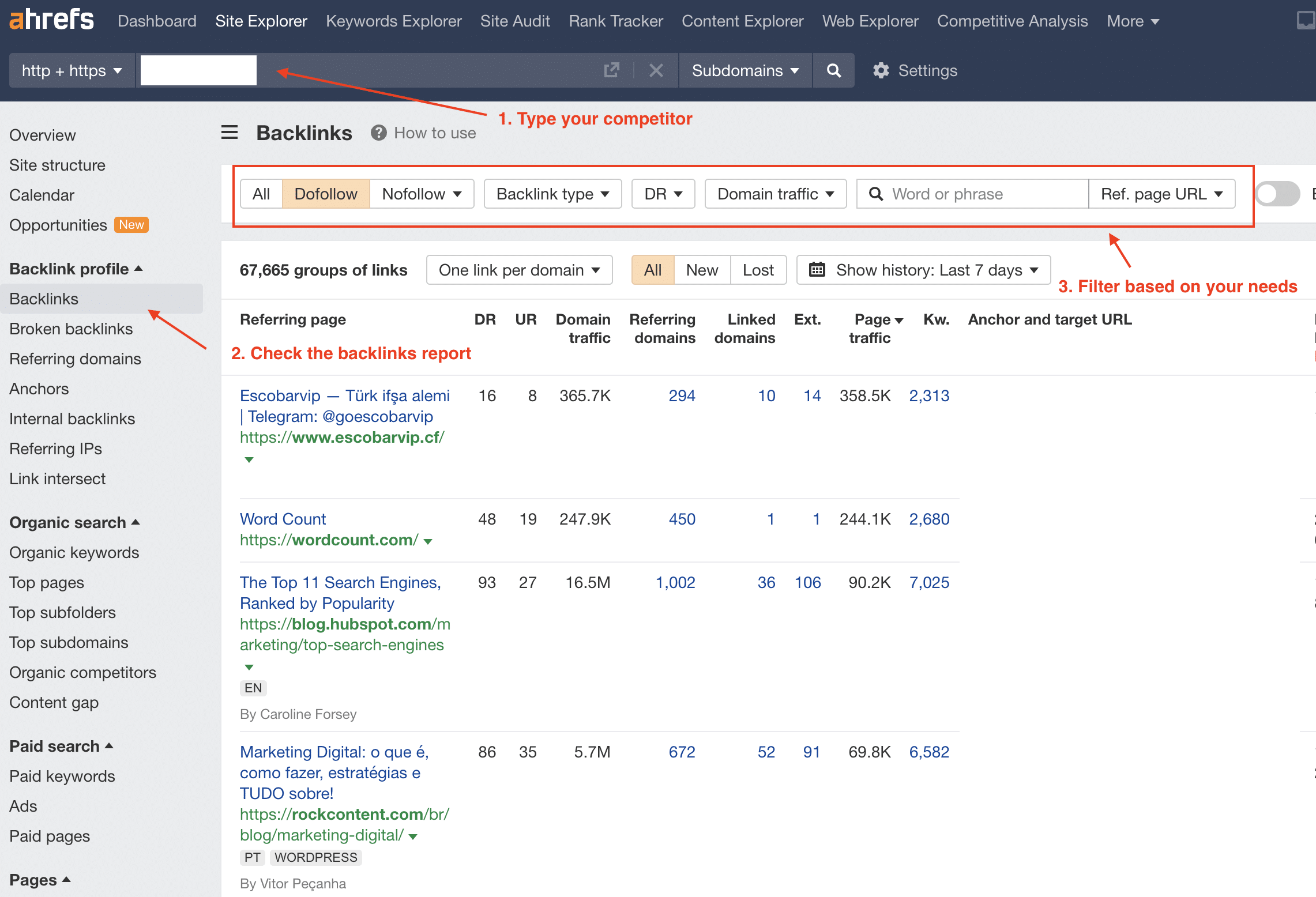
You can enter your competitors’ domains or URLs and see who is linking to them. You can then filter the results by various metrics, such as domain rating, anchor text, etc. You can also see the type of backlinks they have, such as dofollow, nofollow, text, image, etc. This will help you identify potential link opportunities for your own content.
Analyzing your own backlinks.
You can also enter your own domain or URL and see who is linking to you. You can then use the same filters and metrics as above to find relevant and authoritative websites that are already linking to you. You can then reach out to them again and ask them to link to more of your content or update their existing links with newer or better ones.
In a nutshell, the process is exactly the same as you would do for your competitors.
Using the Content Explorer Tool.
Content Explorer scans the web to find high-quality content related to your niche, like authoritative articles in digital marketing. You can filter by keyword to identify relevant pages. Review the content, and if it’s a good fit, do the blogger outreach to request they link back to your site. Build relationships with influencers in your industry to earn backlinks from their content to improve your site’s authority and ranking for target keywords.
Google Search Operators
Google search operators are special commands that you can use to refine your Google search results. They can help you find link prospects by:
Finding websites that are relevant to your niche or industry.
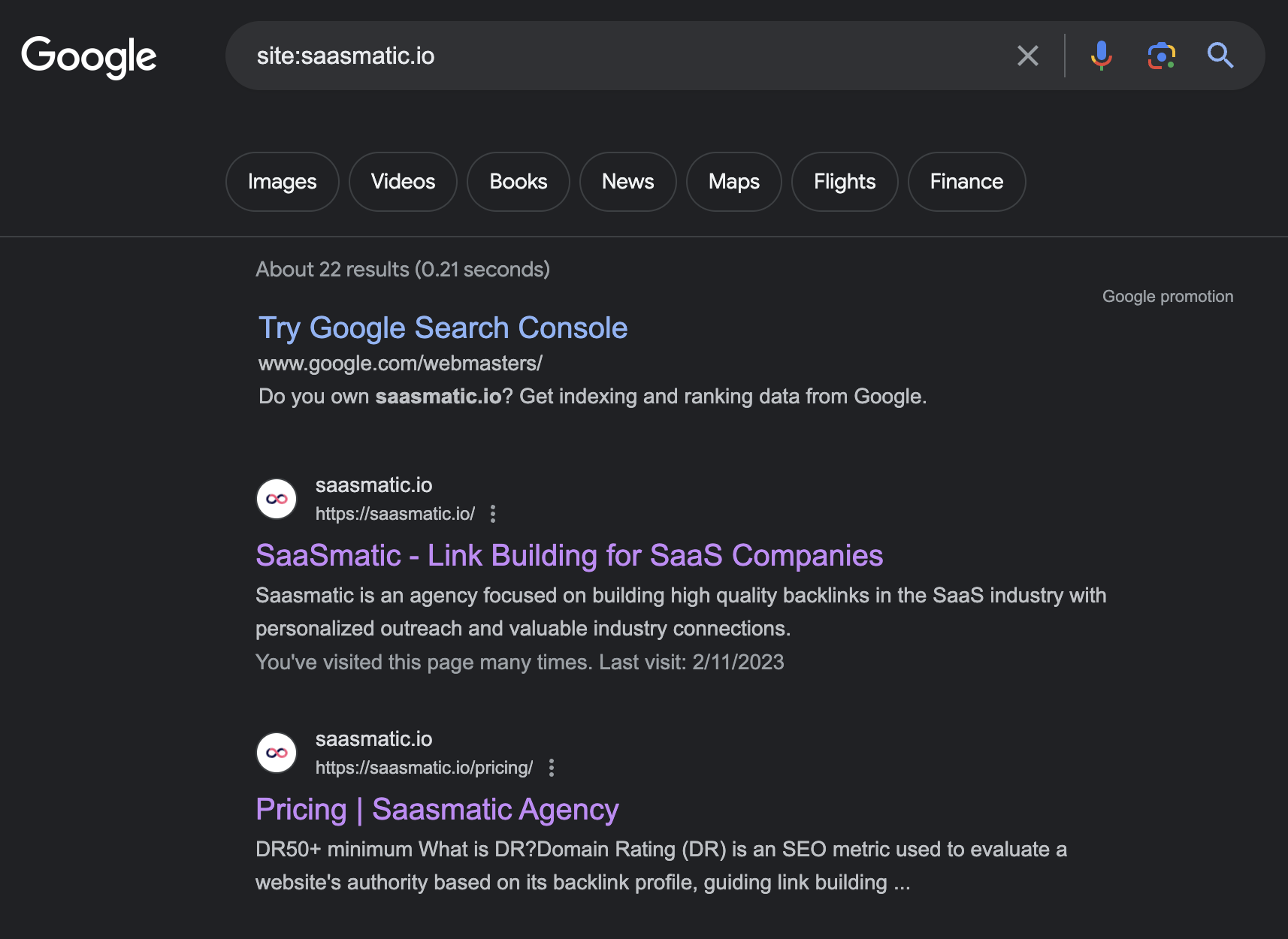
You can use the site: operator to limit your search to a specific domain or website.
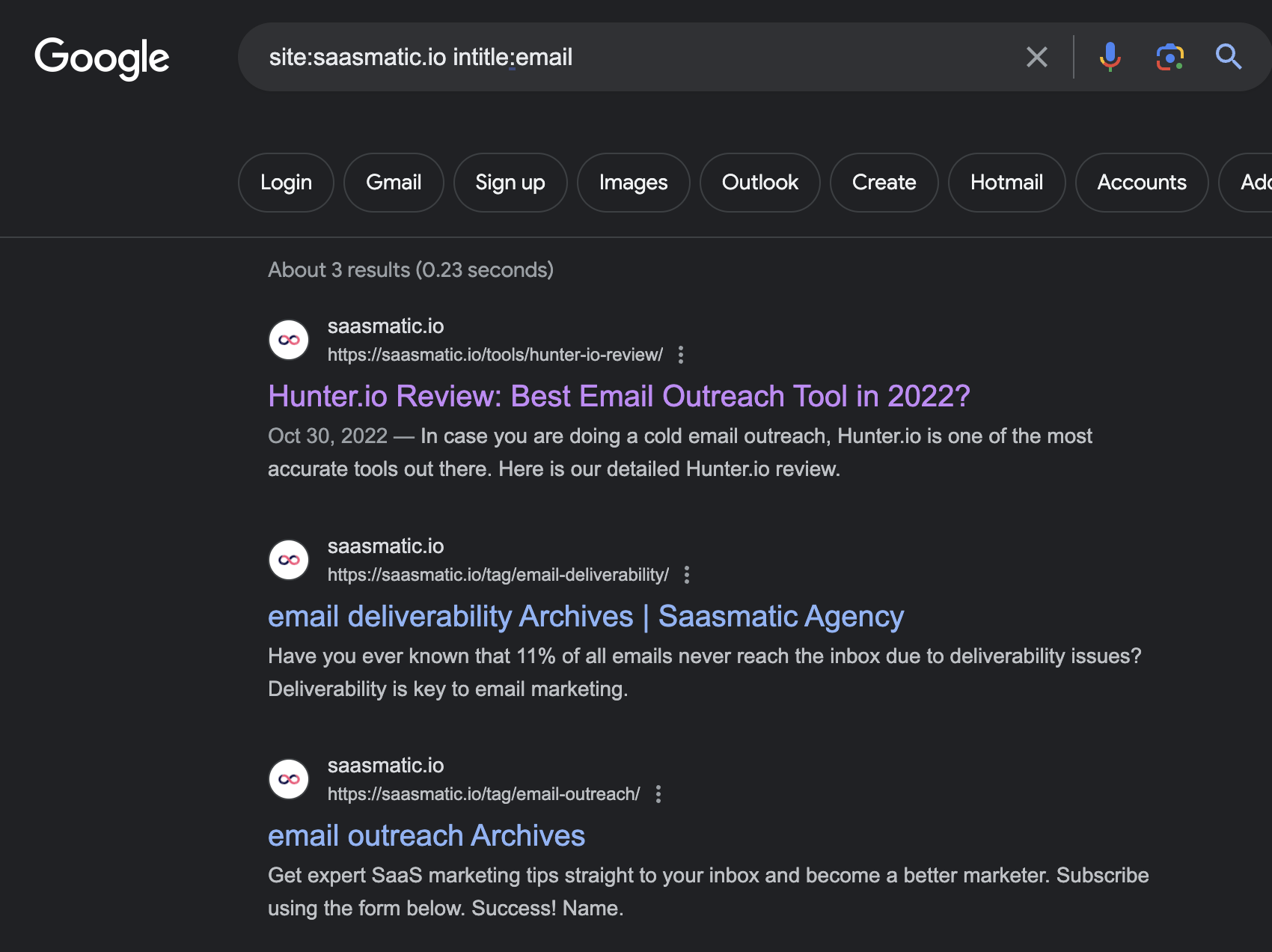
You can also use the intitle: or inurl: operators to find websites that have your target keywords in their title or URL. For example, if you want to find websites that have the word “marketing” in their title, you can use intitle:email.
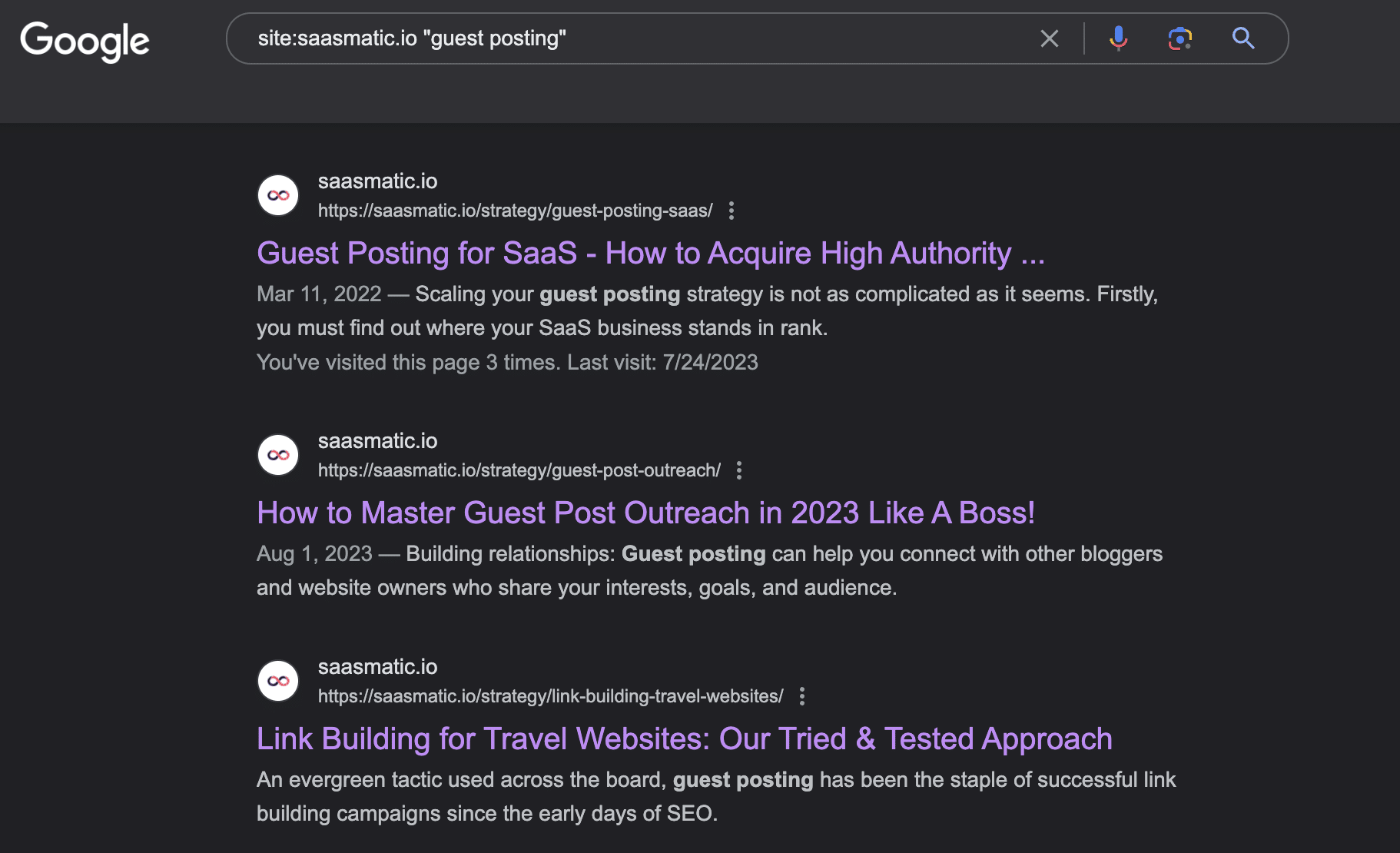
Also, if you found a good fit regarding the domain, but are looking for a specific topic on their page, you can use site:example.com “keyword” to find a desired topic.
Finding websites that have resource pages or link roundups.
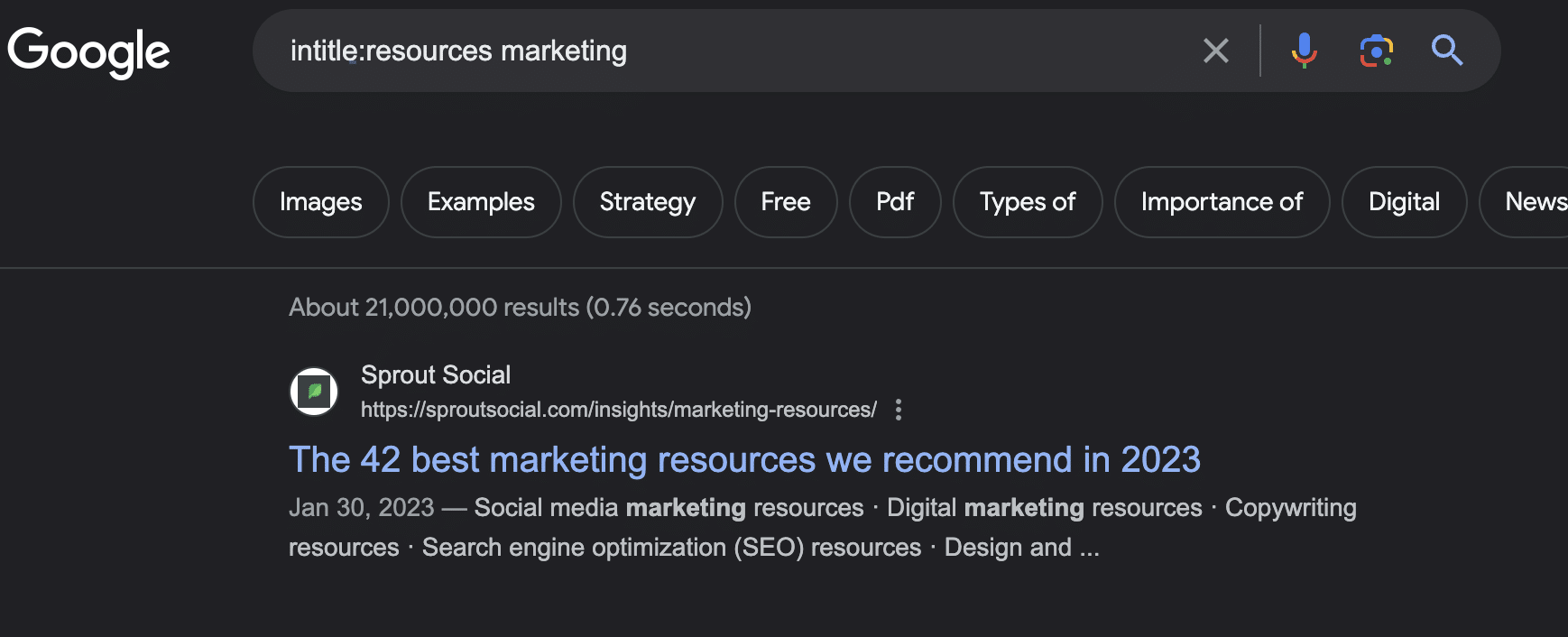
Resource pages and link roundups are pages that list and link to useful resources or articles on a specific topic. They are great places to find link prospects because they are usually relevant and authoritative.
You can use the inurl: operator to find websites that have resource pages or link roundups in their URL. For example, if you want to find websites that have resource pages or link roundups on marketing, you can use inurl:resources marketing or inurl:roundup marketing.
Competitor Analysis
Competitor analysis is another effective way to find link prospects. It involves finding and analyzing your competitors’ websites and content. You can use Ahrefs to do competitor analysis, or you can do it manually by:
- Identifying your competitors. You can use Google search to find your competitors by entering your target keywords and seeing who ranks for them. You can also use social media platforms like Twitter, Facebook, Instagram, etc. to find your competitors by searching for hashtags, keywords, or topics related to your niche or industry.
- Analyzing their content. You can then visit your competitors’ websites and see what kind of content they create and how they promote it. You can look at their blog posts, videos, podcasts, ebooks, webinars, etc. and see what topics they cover, what format they use, what tone they adopt, etc. You can also look at their social media profiles and see how they engage with their audience, what kind of content they share, what feedback they get, etc.
- Analyzing their backlinks. You can then use tools like Ahrefs to analyze their backlinks and see who is linking to them and why. You can look at the quality and relevance of their backlinks, the type and anchor text of their backlinks, the context and placement of their backlinks, etc.
Once you have found and analyzed your competitors’ websites and content, you can use this information to find link prospects for your own content. You can:
- Find websites that are linking to your competitors but not to you. These are potential link opportunities for you because they are already interested in your niche or industry and have linked to similar content before. You can reach out to them and offer them your content as an additional or better resource for their audience.
- Find websites that are not linking to any of your competitors but are relevant and authoritative in your niche or industry. These are potential link opportunities for you because they have a large and engaged audience that can benefit from your content. You can reach out to them and offer them your content as a valuable and unique resource for their audience.
- Find gaps in your competitors’ content and create better content than them. These are potential link opportunities for you because you can create content that is more comprehensive, more up-to-date, more original, more engaging, etc. than your competitors’ content. You can then reach out to the websites that are linking to your competitors’ content and offer them your content as a replacement or improvement for their existing links.
Finding Prospects – Example
Here is a short example of how would I analyze one of the prospects based on the all above. Let’s say I am looking for competitors for the “digital marketing strategies” keyword. Let’s say that I look for domains that have specific metrics:
- DR: 50+
- Domain Traffic: 1,000+
I also have a fictional post that targets the same keyword – so that is the anchor and the link I would like to place on a prospect page.
First, I would look at Google Search for the domains popping up for the “digital marketing strategies” keyword. I toggle the Ahrefs Toolbar to see the metrics in real time.
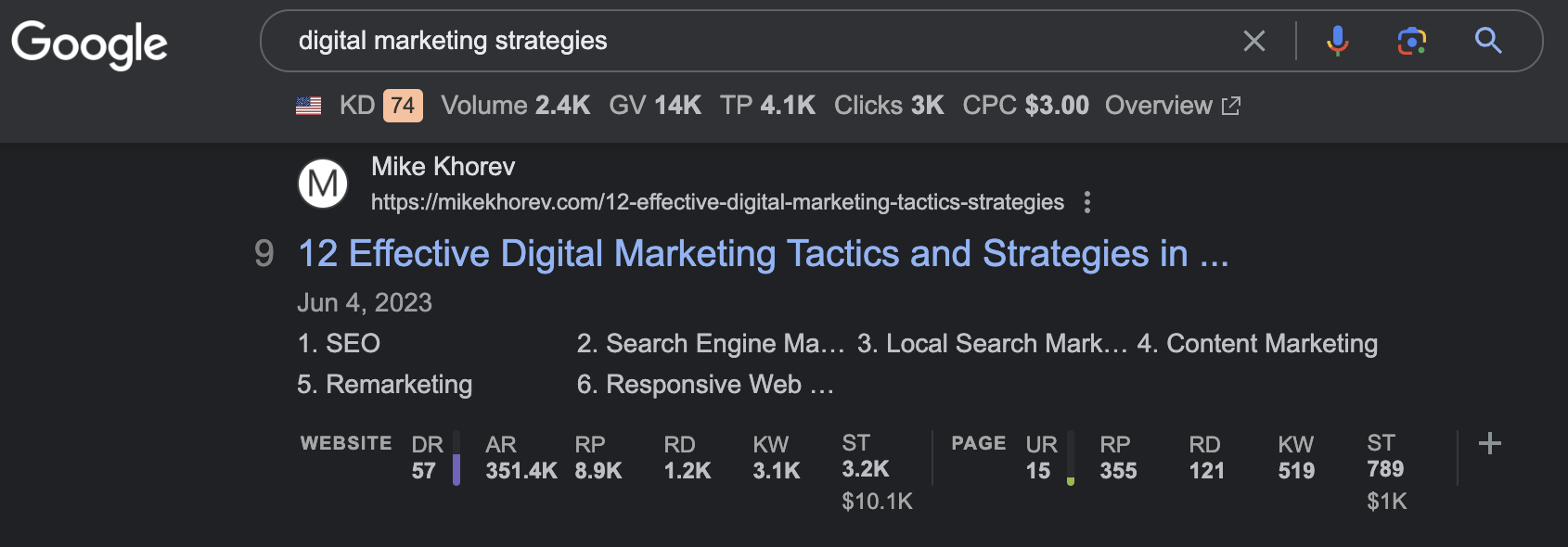
I usually list the first 10 Google Search results and analyze the page-level links. Meaning: links that are pointing to the page. Look at the image above, and see the RD metric on the PAGE tab. This is the number of referring domains, and now we are going to click on that number, which will forward us to the Ahrefs’ Referring domains report.
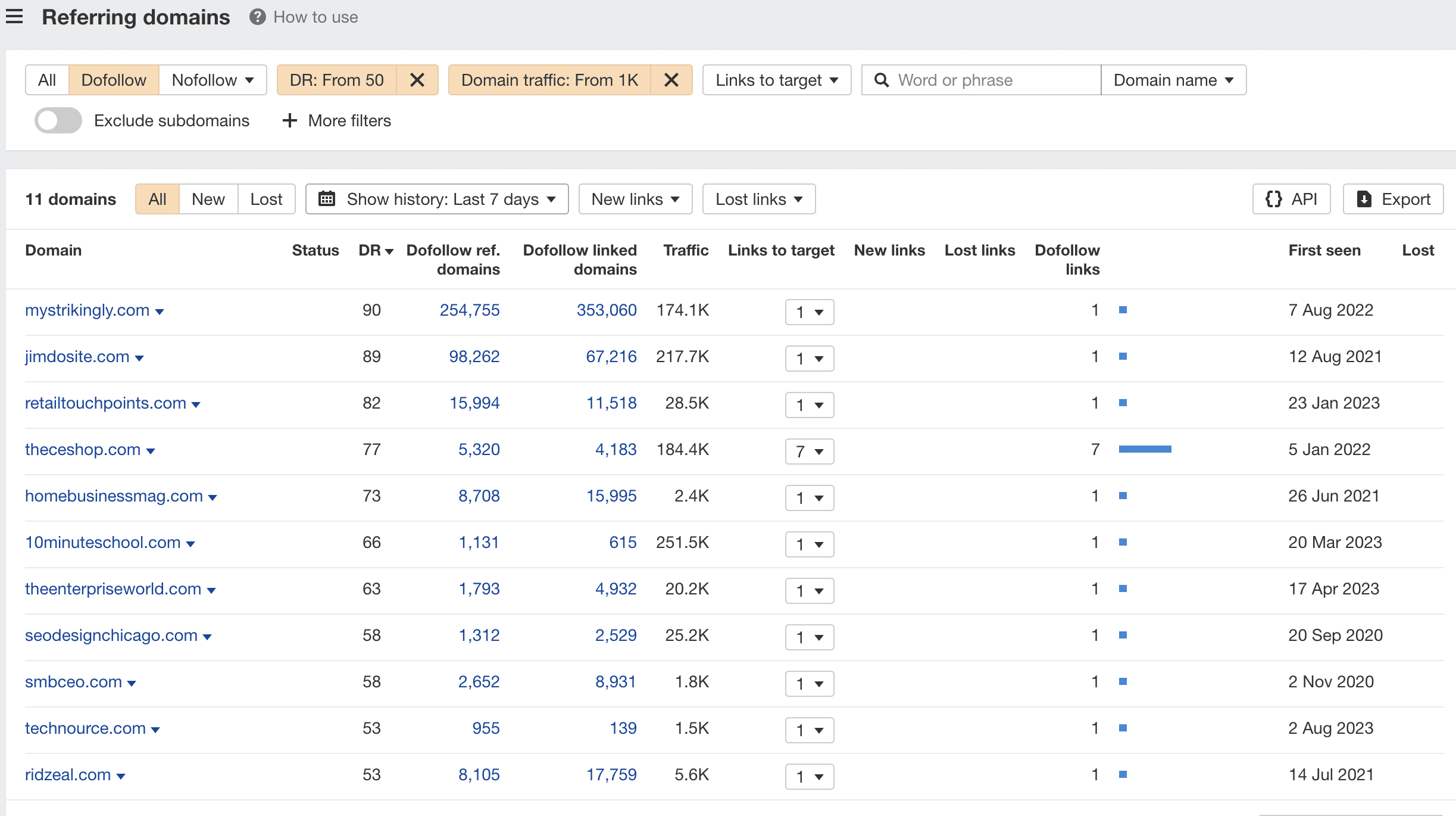
I have also used the filters for DR and Domain traffic to filter out all the unnecessary domains. Usually, I would use the Export button and create a sheet, and repeat this for all the other prospects.
For this example, let’s try to find the right prospect for our fictional digital marketing blog.

Let’s analyze technosource. I can see that they might be a good fit for a couple of reasons:
- They are in the IT business, more specifically – the web and mobile app development
- They fit under our filter for Domain Rating and Site Traffic
- They have a blog section, which means we could place links somewhere where relevant
I want to see if I can find any blog posts that could be in the “digital marketing” sphere on their blog. I can either search directly on their site (if they have a search function) or use the site:technosource.com “digital marketing” search operator.
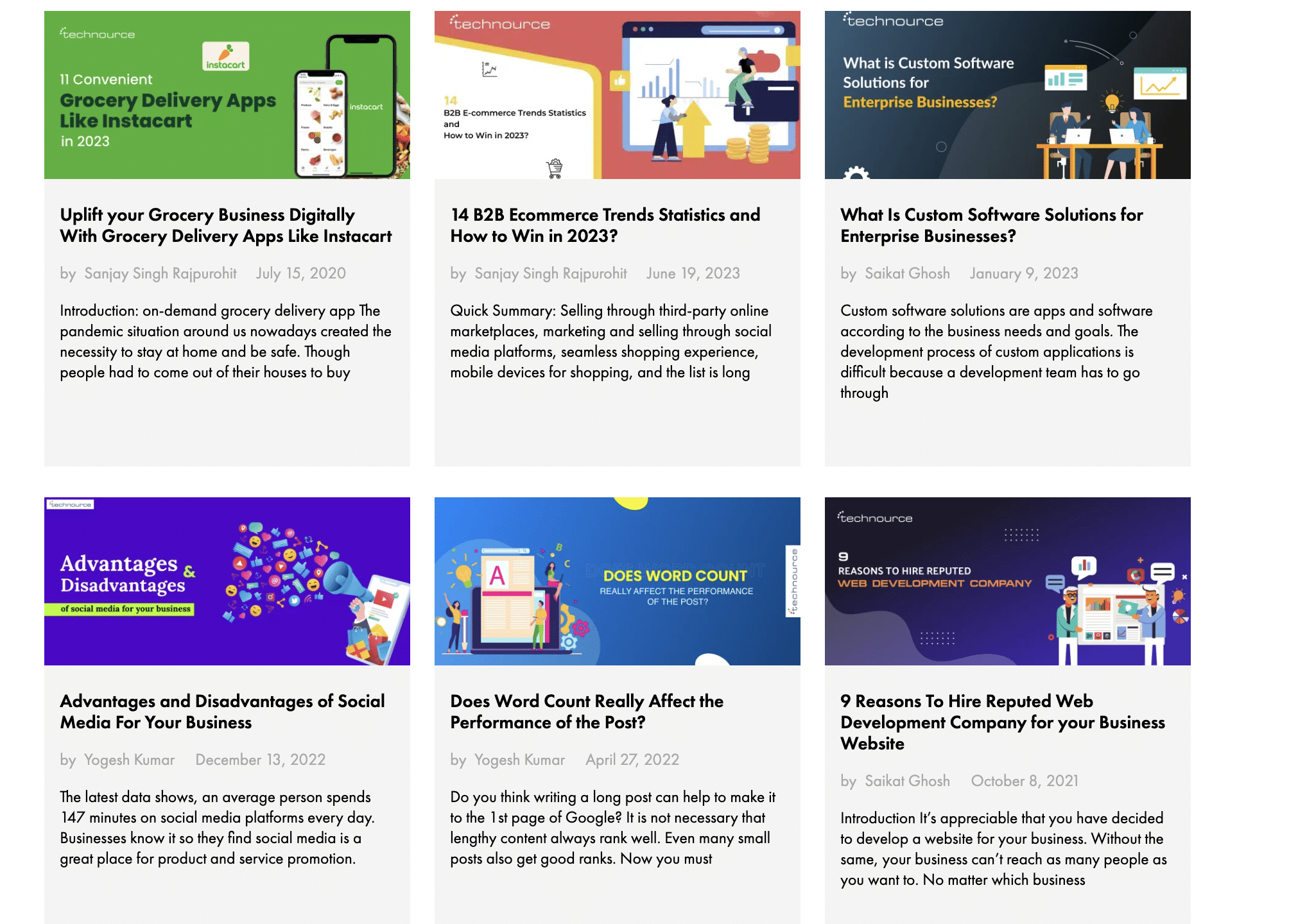
Just on the first glance after doing the search directly on their site, I see a couple of great prospect pages to place my link. But let’s delve deeper into the “Advantages and Disadvantages of Social Media For Your Business”, as this one seems the most suitable.
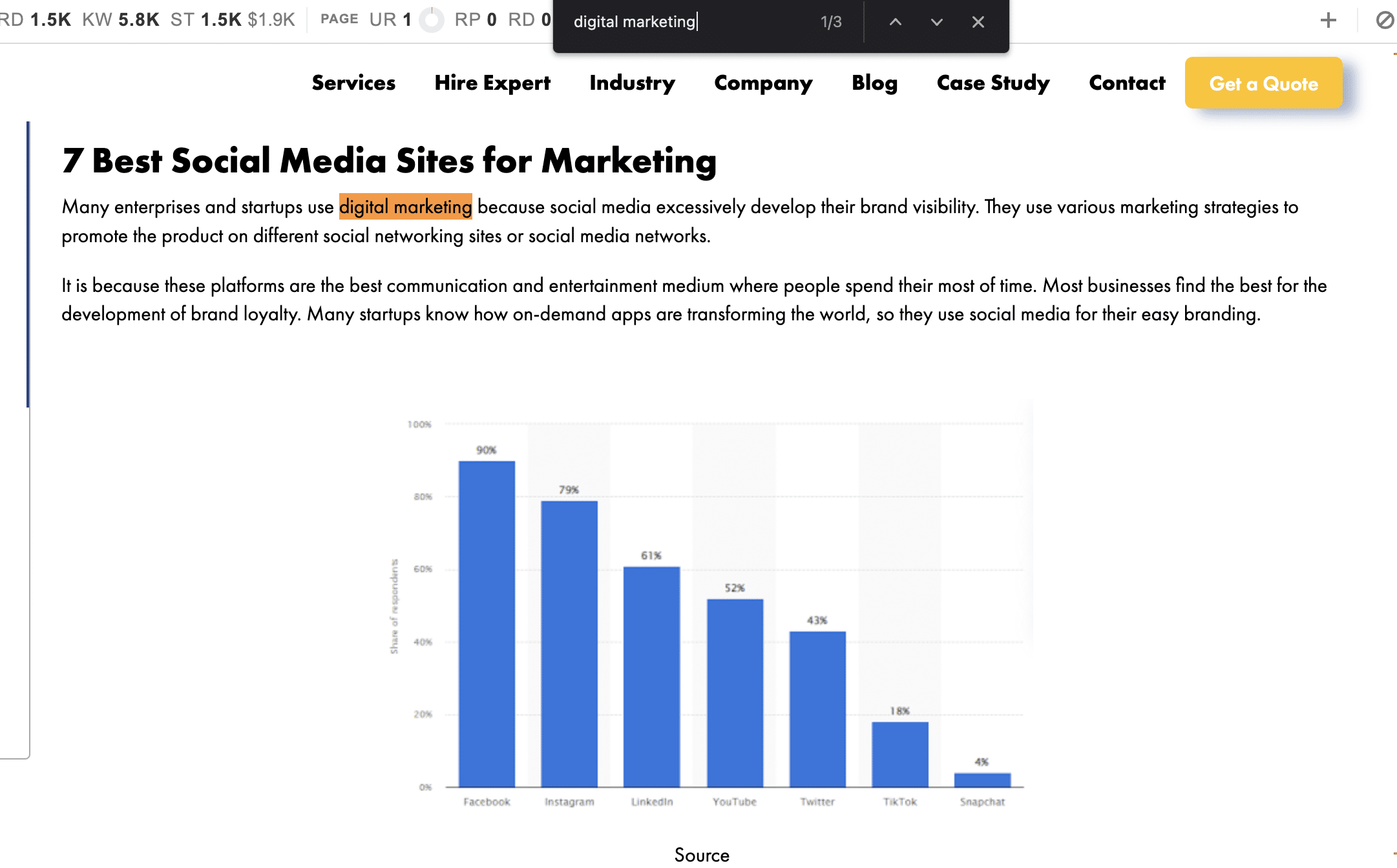
I usually do CTRL+F and type in the broad variant of my target keyword to find the parts in the blog post where I could place my link. In this case, it is “digital marketing”. I see that they have 3 possible locations where I could place my link, but I like the spot from the screenshot from the best. I presume it wouldn’t be tough to place the link on “digital marketing strategies” there.
With that settled, I can conclude that technource is a good prospect, and I can put it in my prospecting sheet.

Let’s not leave you empty-handed! Here is the exact same prospecting template that you can use for your endeavour as well!
Step 2: Find the Right Contact Persons
Of course, you need to find the contact information of the decision-makers on a specific prospect website. We love using Hunter because of its sleek interface and simple user experience. Just type in the domains and you will get contacts with their names, surnames, and positions. For link building, look for these certain roles:
- Content manager
- SEO Specialist/Manager
- Outreach Manager
- Editor
- Media Contact
- CEO
- Co-Founder
- Head of Marketing
Aim for roles connected to marketing, and you should be fine with reaching the right people.
As I still need to find the contact information for our desired prospect – let’s show how Hunter works in action!
First, I am going to type the domain and that will generate me the mails connected to the domain as well as their verification score. When it comes to the verification score, try to aim for 90% and above.
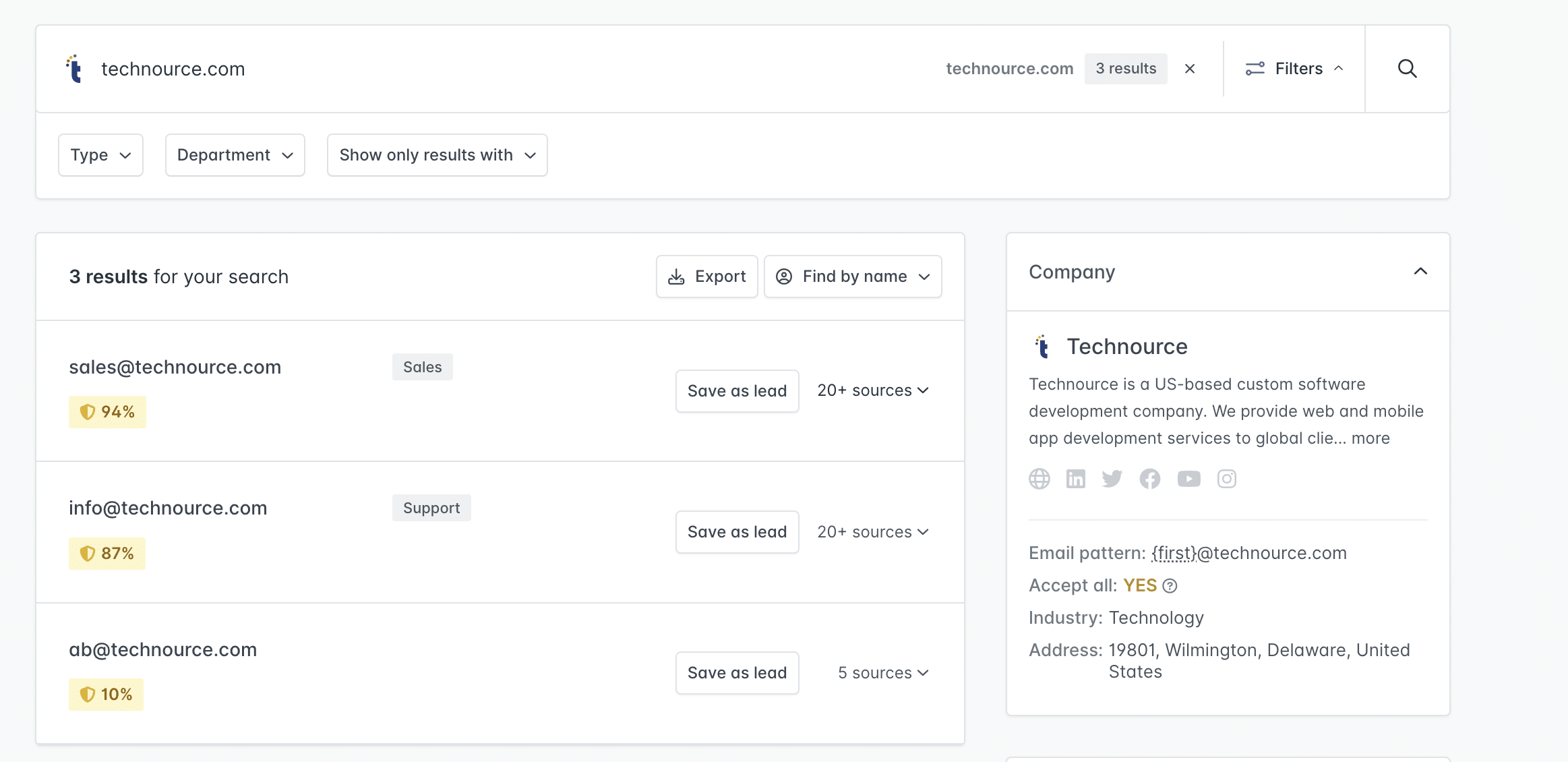
Okay, here, we have a couple of issues:
- There is only one mail that has a verification rating over 90% and it isn’t completely tied to our desired decision-makers
- The mails are not verified completely, which means that they could bounce
- There is not a specific name behind the email
Still, I would go for the sales@technource.com mail as we could always communicate with them to get forwarded to the right person – or that might be the right contact mail after all!
I input it to my prospecting sheet, and now it is full. You can repeat the first two steps for as much prospects you want.

For additional information on how Hunter.io works, and how it can help you achieve the best prospecting results, check out our review of the tool.
Step 3: Create Valuable Content
The second step of link building outreach is creating valuable content. Valuable content is content that is relevant, engaging, and useful for your target audience and link prospects. It is content that solves a problem, answers a question, provides information, entertains, educates, inspires, etc.
But how do you create valuable content? There are many types of content you can create for backlink outreach, but here are some of the most popular and effective ones:
Guides
Guides are long-form content that provide detailed and comprehensive information on a specific topic or problem. They are great for backlink outreach because they provide a lot of value and authority to your audience and link prospects. They also rank well on Google and attract organic traffic.
It is best to write the guides on the topics you have high expertise in – and it is important to provide tons of actionable advice. For example – if you are writing a guide on how to do manual outreach; you want to make sure to:
- Showcase your expertise
- Provide a bunch of actionable examples
- Make it easily digestible by newbies and pros alike
I would say the three pillars above are essential in making a guide hit the jackpot when it comes for link building outreach!
Case Studies
Case studies are content that showcase how you or your clients have achieved a specific goal or solved a specific problem using your product or service. They are great for backlink outreach because they provide social proof and credibility to your audience and link prospects. They also demonstrate the value and benefits of your product or service.
The idea is to showcase a roadmap you took with a specific client:
- Problem. What was the problem of your client? Did he want more links on his pages or just more raw traffic? Defining the problem is important for goal definition.
- Strategy. What is the strategy that you implemented in addressing the problem of your client?
- Results. Of course, you want to showcase results in an easily digestible format (graphs, lots of visuals) to outline that you succeeded in solving your client’s problems.
Without further ado, visit our Case Studies section to see how to write them properly.
Infographics
Infographics are content that use visual elements such as icons, charts, graphs, images, etc. to present information in a concise and attractive way. They are great for backlink outreach because they are easy to consume and share, and they can generate a lot of traffic and social media engagement.
One cool idea we like to do when it comes to ideation of infographics is to look at your existing content. See if it can be easily summarized. Then, put all the key takeaways from that content and pull it into Canva. Determine your style and start designing!
Step 4: Craft Personalized Outreach Emails
The third step of backlink outreach is crafting personalized outreach emails. Outreach emails are emails that you send to your link prospects to introduce yourself, offer your content, and ask for a backlink. They are crucial for backlink outreach because they are the first impression and the main communication channel between you and your link prospects.
But how do you craft personalized outreach emails that get a positive response? There are many best practices, tips, and examples you can use, but here are some of the most important and effective ones:
Use a catchy subject line
The subject line is the first thing that your link prospects will see when they receive your email. It will determine whether they will open your email or ignore it. Therefore, you need to use a catchy subject line that grabs their attention and sparks their curiosity.
Some examples of catchy subject lines are:
- I loved your article on [topic] – here’s something you might like
- Quick question about your [topic] post
- You’re featured in our latest [type of content] on [topic]
- How to [achieve a goal or solve a problem] with [your content]
- I have a [type of content] idea for you – are you interested?
To create a catchy subject line, you need to:
- Use your target keyword or topic to show relevance and interest
- Use personalization to show respect and rapport
- Use numbers, questions, emojis, etc. to create intrigue and urgency
- Use clear and concise language to communicate the value proposition of your email
- Use A/B testing to find the best performing subject line
Address the recipient by name
The salutation is the second thing that your link prospects will see when they open your email. It will determine whether they will read your email or delete it. Therefore, you need to address the recipient by name to show respect and rapport.
Some examples of salutations are:
- Hi [name],
- Hello [name],
- Dear [name],
To address the recipient by name, you need to:
- Find their name from their website, social media profiles, email address, etc.
- Use their first name or full name depending on the level of formality and familiarity
- Capitalize their name correctly and avoid spelling errors
- Avoid generic salutations such as “Hi there”, “Dear sir/madam”, “To whom it may concern”, etc.
Compliment their work
The introduction is the third thing that your link prospects will see when they read your email. It will determine whether they will trust you or doubt you. Therefore, you need to compliment their work to show appreciation and admiration.
Some examples of compliments are:
- I’m a huge fan of your blog – especially your post on [topic]
- I really enjoyed reading your article on [topic] – it was very informative and insightful
- I was impressed by your [type of content] on [topic] – it was very creative and engaging
To compliment their work, you need to:
- Be specific and genuine about what you liked about their work
- Mention their work by title or URL to show that you have actually read or seen it
- Explain how their work helped you or inspired you to create your own content
Explain the value proposition of your content
The body is the fourth thing that your link prospects will see when they read your email. It will determine whether they will be interested in your content or not. Therefore, you need to explain the value proposition of your content to show how it can benefit them and their audience.
Some examples of value propositions are:
- I’ve created a [type of content] on [topic] that covers [main points or benefits]
- I’ve just published a [type of content] on [topic] that reveals [main points or benefits]
- I have a [type of content] on [topic] that teaches [main points or benefits]
To explain the value proposition of your content, you need to:
- Be specific and concise about what your content is and what it offers
- Highlight the main points or benefits of your content that are relevant and useful for your link prospects and their audience
- Use numbers, statistics, facts, etc. to quantify and qualify the value of your content
- Use social proof, testimonials, reviews, etc. to validate and reinforce the value of your content
Ask for a backlink
The conclusion is the fifth and final thing that your link prospects will see when they read your email. It will determine whether they will take action or not. Therefore, you need to ask for a backlink to your content in a clear and polite way.
Some examples of backlink requests are:
- Would you be interested in linking to my [type of content] on [topic] from your [page title or URL]?
- I think your readers would love my [type of content] on [topic]. Would you mind adding a link to it from your [page title or URL]?
- I would really appreciate it if you could link to my [type of content] on [topic] from your [page title or URL]. It would be a great resource for your audience.
To ask for a backlink, you need to:
- Be clear and direct about what you want and why you want it
- Be polite and respectful and avoid being pushy or demanding
- Be specific and relevant and mention the exact page or URL where you want them to link to your content
- Provide a reason or an incentive for them to link to your content, such as adding value, updating information, fixing errors, etc.
Sign off with your name and contact information
The signature is the last thing that your link prospects will see when they finish reading your email. It will provide them with your name and contact information so that they can reply to you or reach out to you. Therefore, you need to sign off with your name and contact information in a professional and friendly way.
Some examples of signatures are:
- Cheers, [Your name] [Your title] [Your website] [Your social media links]
- Regards, [Your name] [Your title] [Your website] [Your social media links]
- Thanks, [Your name] [Your title] [Your website] [Your social media links]
To sign off with your name and contact information, you need to:
- Use a simple and courteous closing phrase such as “Cheers”, “Regards”, “Thanks”, etc.
- Use your full name or first name depending on the level of formality and familiarity
- Use your title or role to show your credibility and authority
- Use your website or landing page to show your brand and offer
- Use your social media links to show your presence and engagement
Step 5: Build Relationships and Follow Up
The fourth and final step of backlink outreach is building relationships and following up with your link prospects. Building relationships and following up are essential for backlink outreach because they can increase your chances of getting a positive response and a backlink from your link prospects. They can also help you establish trust and rapport with your link prospects and turn them into loyal fans and customers.
But how do you build relationships and follow up with your link prospects? There are many ways to do so, but here are some of the most common and effective ones:
Provide feedback
Providing feedback is a great way to build relationships and follow up with your link prospects. It shows that you care about their work and appreciate their efforts. It also shows that you are an expert and a valuable resource in your niche or industry.
Some examples of feedback are:
- Thanking them for linking to your content or considering your request
- Complimenting them on their work or achievements
- Offering suggestions or tips to improve their work or results
- Asking questions or clarifying doubts about their work or content
- Sharing your own experiences or insights related to their work or content
To provide feedback, you need to:
- Be specific and genuine about what you liked or disliked about their work or content
- Be positive and constructive and avoid being negative or critical
- Be relevant and useful and avoid being irrelevant or spammy
- Be timely and consistent and avoid being late or irregular
Share their content
Sharing their content is another great way to build relationships and follow up with your link prospects. It shows that you support their work and value their content. It also shows that you are generous and helpful in your niche or industry.
Some examples of sharing their content are:
- Sharing their content on your social media platforms such as Facebook, Twitter, LinkedIn, etc.
- Mentioning their content in your blog posts, videos, podcasts, ebooks, webinars, etc.
- Featuring their content in your newsletters, emails, roundups, etc.
- Recommending their content to your audience, clients, customers, etc.
To share their content, you need to:
- Be selective and relevant and only share content that is related to your niche or industry
- Be respectful and courteous and give credit to the original source
- Be engaging and informative and add value to the content by providing your own commentary, opinion, analysis, etc.
- Be interactive and social and tag them, mention them, reply to them, etc.
Comment on their blog posts
Commenting on their blog posts is another great way to build relationships and follow up with your link prospects. It shows that you read and appreciate their content and value their opinions. It also shows that you are active and engaged in your niche or industry.
Some examples of commenting on their blog posts are:
- Praising them for their content or insights
- Adding your own perspective or experience to their content
- Asking questions or starting a discussion about their content
- Providing feedback or suggestions to improve their content
- Linking to your own content or resources that are relevant and useful for their content
To comment on their blog posts, you need to:
- Be respectful and polite and avoid being rude or offensive
- Be relevant and useful and avoid being irrelevant or spammy
- Be concise and clear and avoid being vague or confusing
- Be original and authentic and avoid being generic or copy-pasting
- Be timely and consistent and avoid being late or irregular
Backlink Outreach is Easy to Learn – Hard to Master!
Backlink outreach is one of the most effective and challenging SEO strategies. It can help you increase your traffic, authority, and rankings. But it also requires a lot of research, planning, creativity, and persistence.
Now it’s your turn to implement these steps and start building backlinks like a pro. We hope you found this guide helpful and useful. 😊
If you want to skip all the hassle with the backlink outreach – we can always do it for you. Don’t hesitate to contact us for our manual outreach services that will help you up your SEO game!

